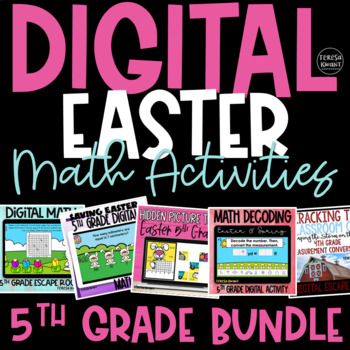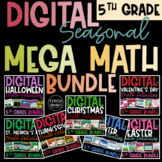5th Grade Digital Easter and Spring Math Activities and Centers
- Zip
- Google Apps™
- Internet Activities

Products in this Bundle (5)
Also included in
- Digital activities are the perfect no-prep solution to your lessons! With this MEGA bundle, 7 seasonal digital math activity bundles are included! There are 35 different games to choose from! All the activities are digital, but can be used with virtual learning, or in the classroom. These products aPrice $25.00Original Price $115.93Save $90.93
Description
This bundle of math games is full of 5 different and engaging math digital activities. Use them for center time, bell work, partner work, review, and more! Students can use these at home with distance learning, or in the classroom!
#1 Digital Math Escape Room on Google Slides or PowerPoint
This is a fun Google Slides escape room that reviews key concepts for 5th grade! Students will practice plotting ordered pairs, and using the coordinate grid. Your class will enjoy the bunny and Easter egg theme. Use it with your virtual or in-person class. Great for the month of March or April, and leading up to Easter.
There are 15 escapes. Students will click and drag number tiles, click and drag Valentine objects, put puzzles together, use a magnifying glass, and more! This is very interactive and engaging. Not only is it educational, it is simple to figure out and play for students. Students can play individually, with a partner, or small group. Use it during school in class, for distance learning, as a center activity, or to review for a test. Your students will be begging for more once they play!
The game is provided in both a Google Slides and PowerPoint format!
Escape rooms are a great way to get students working together, solving problems, and reviewing concepts they have learned in class.
#2 Hidden Picture Tiles
This product works great for distance learning, or in a classroom. Engage your students with a fun math review game on Google Slides. Students will simply click and drag the correct answer to match the question. These are great for the months of March and April, as well as leading up to Easter. Students will review key standards taught in 5th grade. The Common Core was referenced when creating this game. The concepts focused on include finding points and ordered pairs on the coordinate grid. Students will only work with quadrant 1. Students will also practice converting measurements.
This activity is self-grading, because students will create a picture, if completed correctly. Don't worry about copies, wasting printer ink, grading work, or students doing busy work with this meaningful Google Slides review exercise.
There are 15 secret pictures included. Assign them throughout the the entire month.
These hidden pictures can be used on any device! They are completely digital, and created on Google Slides.
Make math fun with these engaging Spring and Easter themed math activities. Perfect for center time, bell work, self-starters, early finishers, exit tickets, review, and so much more!
#3 Math Decoding
This is a fun, educational, and easy to learn digital activity. Provided in both a PowerPoint AND Google Slides format, it works with distance learning and in-classroom learning. Whether you are teaching in a virtual classroom or physical one, use these math decoding slides to reinforce measurement conversions with your students. Both customary units of measure and the metric system are included. The questions are all based on Common Core standards for 5th grade.
These are perfect for the month of March or April and leading up to Easter. With this activity, students will drag and drop the numbers to decode the secret times. This game is to be played in edit mode, not presentation mode. These slides can be used on any device.
Make math fun with this engaging Easter themed math activity. It is perfect for center time, bell work, self-starts, early finishers, exit tickets. math review, test prep, and more!
#4 Saving Easter Math Review Game
Try this fun Easter themed math game with your 4th grade students today! Created in Google Slides, it is a no-prep activity. This game can be played virtually with distance learning, or in the classroom. Use it for centers, rotations, bell work, exit tickets, homework, test review, and more! Play as a whole class, in small groups, or even individually.
Students will practice converting measurements. Word problems are included. As students click on the bunnies, they will either find a basket with eggs, or an empty basket. A basket with eggs means they can continue on to the next question. An basket with no eggs means they must try again. This game is self-grading, because as students play, they will know right away if they got the answer correct or not.
An answer key and instructions to play are provided. This game is created in Google Slides. There are 25 questions included.
The game is very user-friendly, and your students will be able to pick it up quickly. Students MUST play this in “Present” mode.
#5 Spring Math Escape Room on Google Slides
*UPDATED WITH A SECOND DIGITAL OPTION THAT IS PERFECT FOR DISTANCE LEARNING. Now, there are two digital versions included! One without printables that is easy to assign for distance learning on Google Forms, and a second one on Google Forms that requires some printables to be used in the classroom. This digital escape room is a fun way to get your kids engaged in math. The game is for 5th grade, and focuses on measurement conversions. Get your students excited to do math as they try and save the animals from the approaching storm on the farm!
This game is digital and requires *almost* no prep! There are 2 spinners, a secret decoder, mystery math page, and an emoji code that must be printed out and hidden in the room. The rest of the game will be played digitally!
Technology Requirements:
- A Google Drive account
- If sharing with students, a Drive account that is linked to student Google accounts
- Can be shared/delivered on Google Classroom
- Only need access to Google Drive--no outside links to worry about!
This escape room can be used with iPads, chrome books, laptops, and desktops as long as your students have access to Google Drive or Classroom on a device. The escape room is on a Google Form. Students must answer the questions correctly to advance to the next section, and eventually escape.
Escape rooms are a great way to get students working together, solving problems, and reviewing concepts they have learned in class.



